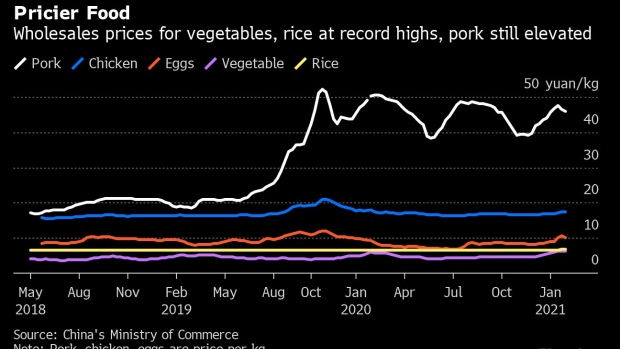Feb 3, 2021
China’s Rising Food Costs Mean Empty Purses for Holiday Feast
, Bloomberg News

(Bloomberg) -- Wang Chunxia, a retiree in China, has started shopping for the big Lunar New Year feast for her family of five, and she’s worried at just how much she’ll need to fork out for even the basics like meat and veg.
“Prices of vegetables, pork, fish and shrimps are all rising,” said Wang, who lives in the small city of Baoji in the northern province of Shaanxi. Spending on this year’s celebrations could set her back more than 1,000 yuan ($155), double last year’s amount and close to what she gets as a monthly pension, she said.
The unfortunate timing of the spike in prices is due to the resurgence of the coronavirus, which China had thought contained, and a much chillier-than-usual winter. The combination of events is raising food costs and nudging up inflation just as households demand heaving tables for the new year festivities.
Pork prices, which had been in retreat after a rapid recovery in pig numbers following the African swine fever outbreak, have returned to near their September highs. A logjam at ports is affecting the supply of China’s favorite meat as well as seafood as the authorities demand inspections of all frozen food imports after traces of the coronavirus were found on food and packaging.
Costly Cabbages
Vegetable prices have skyrocketed due to the unusually cold weather, which damaged crops in the main growing areas of the south. The commerce ministry’s wholesale price index of agricultural goods surged to an all-time high last month, with cabbages and cauliflowers registering the biggest increases.
Logistical constraints because of travel restrictions to control the spread of the virus are hindering the transport of fruit and vegetables. In recent weeks, swathes of northern China, home to tens of millions of people, have gone into lockdown after a surge in cases centered on Hebei province. Truck drivers delivering produce to Beijing from southern regions such as Hainan, Yunnan and Sichuan have to pass through Hebei and undergo testing.
And to cap it all, financial markets for farm products are running red hot. Corn and soybean prices on the Dalian Commodity Exchange have soared to all-time highs, even with record imports in 2020, as China scours the world to feed its massive pig population. China’s efforts to boost growth in the wake of the pandemic by loosening the supply of money are also partly to blame, according to Ma Wenfeng, an analyst at Beijing Orient Agribusiness Consultant Co.
“Many are betting on farm products because these are daily life essentials, including wheat, corn, soybean and vegetables,” said Ma.
Braised Beef
With the Spring Festival looming, policy makers are reassuring consumers that there’s ample supply. Domestic pork supplies could be about 25% higher in January and February compared to last year, according to the agriculture ministry. The authorities are also offering larger amounts of wheat and pork from state reserves for sale.
Food prices are expected to ease, but only after the holiday. The government is likely to tighten monetary policy, particularly in the second half of the year, which will curb speculation on agricultural markets, said Meng Jinhui, a senior analyst at Shengda Futures Co. Massive grain imports, further releases of state reserves, and the continued recovery in the hog herd should also help cool markets.
That’s little immediate comfort for Wang and her family. She’s already decided to forgo favorites such as pork rind jelly and braised beef shank, popular cold dishes during the festival, but she’s reluctant to scale back further on the most important meal of the year.
“It’s once a year and no matter how expensive it is, you’ve got to have these dishes for the reunion dinner,” she said.
©2021 Bloomberg L.P.


